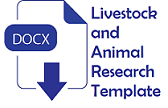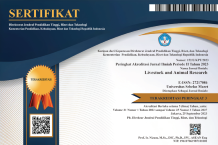Emisi metan dan fermentasi rumen in vitro dari ransum yang ditambahkan kitosan asal kulit udang
Abstract
Tujuan: Penelitian ini dilakukan untuk mengevaluasi pengaruh penambahan kitosan asal kulit udang pada dosis yang berbeda ke dalam ransum basal terhadap emisi gas metan dan fermentasi rumen secara in vitro.
Metode: Perlakuan terdiri dari: P0 (ransum basal), P1 (ransum basal + kitosan 2% BK), dan P2 (ransum basal + kitosan 4% BK). Variabel yang diukur adalah kinetika produksi gas, produksi metan dinyatakan dalam produksi metan per unit bahan kering sampel dan produksi metan per unit bahan organik yang dicerna, kecernaan bahan kering (KCBK), kecernaan bahan organik (KCBO), volatile fatty acid (VFA), dan amonia (NH3).
Hasil: Hasil penelitian menunjukkan bahwa penambahan kitosan 2% dan 4% BK dapat menurunkan secara signifikan (P<0,05) total produksi gas, laju produksi gas dan produksi metan. Namun demikian penambahan kitosan asal kulit udang pada tidak berbeda nyata terhadap peubah KCBK, KCBO, VFA, dan NH3 (P>0,05).
Kesimpulan: Dapat disimpulkan bahwa kitosan dalam pakan bermanfaat dalam menurunkanemisi gas metan secara in vitro.
Keywords
Full Text:
PDF (Bahasa Indonesia)References
Hristov, A. N., T. Ott, J. Tricarico, A. Rotz, G. Waghorn, A. Adesogan, J. Dijkstra, F. Montes, J. Oh, and E. Kebreab. 2013. Mitigation of methane and nitrous oxide emissions from animal operations: III. A review of animal management mitigation options. J. Anim. Sci. 91:5095-5113. doi:10.2527/jas.2013-6585.
Kaharabata, S. K., P. H. Schuepp, and R.L Desjardins. 2015. Estimating methane
emissions from dairy cattle housed in a barn and feedlot using an atmospheric tracer. Environ. Sci. Technol. 34:3296-3302. doi:10.1021/es990578c.
Patra, A. K. and J. Saxena. 2011. Exploitation of dietary tannins to improve rumen metabolism and ruminant nutrition. J. Sci. 91:24-37. doi:10.1002/jsfa.4152.
Jayanegara, A., K. A. Sarwono, M. Kondo, H. Matsui, M. Ridla, E. B. Laconi, and Nahrowi. 2018. Use of 3-nitrooxypropanol as feed additive for mitigating enteric methane emissions from ruminants: a meta-analysis. Ital. J. Anim. Sci. 17:650-656. doi:10.1080/1828051X.2017.1404945.
Wina, E., S. Muetzel, and K. Becker. 2005. The impact of saponins or saponin-containing plant materials on ruminant production - a review. J. Agric. Food Chem. 53:8093-8105. doi:10.1021/jf048053d.
Haryati, R. P., A. Jayanegara, E. B. Laconi, M. Ridla, and P. Suptijah. 2019. Evaluation of chitin and chitosan from insect as feed additives to mitigate ruminal methane emission. In: AIP Conf. Proc. 2120:040008.
Zanferari, F., T. H. A. Vendramini, M. F. Rentas, R. Gardinal, G. D. Calomeni, L. G. Mesquita, C. S. Takiya., and F. P. Rennó. 2018. Effects of chitosan and whole raw soybeans on ruminal fermentation and bacterial populations, and milk fatty acid profile in dairy cows. J. Dairy Sci. 101:10939-10952. doi:10.3168/jds.2018-14675.
Goiri, I., A. Garcia-Rodriguez, and L. Oregui. 2009. Effects of chitosans on in vitro rumen digestion and fermentation of maize silage. Anim. Feed Sci. Tech. 148:276-287. doi:10.1016/j.anifeedsci.2008.04.007.
AOAC. 2005. Official methods of analysis. 18th ed. Assoc. Off. Anal. Chem., Maryland Gaithersburg, USA.
Jayanegara, A., M. Ridla, D. A. Astuti, K. G. Wiryawan, E. B. Laconi, and Nahrowi. 2017. Determination of energy and protein requirements of sheep in indonesia using a meta-analytical approach. Media Peternakan. 40:118-127.
doi:10.5398/medpet.2017.40.2.118.
Theodorou, M. K., B. A. Williams, M. S. Dhanoa, A. B. McAllan, and J. France. 1994. A simple gas production method using a pressure transducer to determine the fermentation kinetics of ruminant feeds. Anim. Feed Sci. Tech. 48: 185-197. doi:10.1016/0377-8401(94)90171-6.
Orskov, E. R. and I. McDonald. 1979. The estimation of protein degradability in the rumen from incubation measurements weighted according to rate of passage. J. Agri. Sci. 92:499-503. doi:10.1017/S0021859600063048.
Tilley, J. M. A. and R. Terry. 1963. A two-stage technique for the in vitro digestion of forage crops. Grass Forage Sci. 18:104-111. doi:10.1111/j.1365-2494.1963.tb00335.x.
Jayanegara, A., S. P. Dewi, N. Laylli, E. B. Laconi, N. Nahrowi, and M. Ridla. 2016. Determination of cell wall protein from selected feedstuffs and its relationship with ruminal protein digestibility in vitro. Media Peternakan. 39:134-140. doi:10.5398/medpet.2016.39.2.134.
Vyas, D., S. McGinn, and S. Duval. 2016. Effects of sustained reduction of enteric methane emissions with dietary supplementation of 3-nitrooxypropanol on growth performance of growing and finishing beef cattle. J. Anim. Sci. 94:2024-2034. doi:10.2527/jas.2015-0268.
Maccarana, L., M. Cattani, F. Tagliapietra, S. Schiavon, L. Bailoni, and R. Mantovani. 2016. Methodological factors affecting gas and methane production during in vitro rumen fermentation evaluated by meta-analysis approach. J. Anim. Sci. Biotechno. 7:35. doi:10.1186/s40104-016-0094-8.
Goiri, I., L. M. Oregui, and A. Garcia-Rodriguez. 2009. Dose-respon effects of chitosans on in vitro rumen digestion and fermentation of mixtures differing in forage-to-concentrate ratios. Anim. Feed Sci. Tech. 151:215-227. doi:10.1016/j.anifeedsci.2009.01.016.
Goiri, I., L. M. Oregui, and A. Garcia-Rodriguez. 2010. Use of chitosans to modulate ruminal fermentation of a 50:50 forage-to-concentrate diet in sheep. J. Anim. Sci. 88:749-755. doi:10.2527/jas.2009-2377.
Belanche, A., E. Ramos-Morales, and C. J. Newbold. 2016. In vitro screening of natural feed additives from crustaceans, diatoms, seaweeds and plant extracts to manipulate rumen fermentation. J. Sci. 9:3069-3078. doi:10.1002/jsfa.7481.
Wang, Y., T. McAllister, L. Rode, K. Beauchemin, and D. Morgavi. 2001. Effects on exogenous enzyme preparation on microbial protein synthesis, enzyme activity and attachment to feed in the Rumen Simulation Technique (RUSITEC). Br. J. Nutr. 85:325-332. doi:10.1079/bjn2000277.
Gandra, J.R., C. S. Takiya, T. A. Del Valle, E. R. Oliveira, R. H. T. B. de Goes, E. R. S. Gandra, J. D. O. Batista, and H. M. C. Araki. 2018. Soybean whole-plant ensiled with chitosan and lactic acid bacteria: Microorganism counts, fermentative profile, and total losses. J. Dairy Sci. 101:7871-7880. doi:10.3168/jds.2017-14268.
Wencelova, M., Z. Varadyova, K. Mihalikova, S. Kisidayova, and D. Jalc. 2014. Evaluating the effects of chitosan, plant oils, and different diets on rumen metabolism and protozoan population in sheep. Turk. J. Vet. Anim. Sci. 38:26-33. doi:10.3906/vet/1307-19.
Kong, M., X. G. Chen, K. Xing, and H. J. Park. 2010. Antimicrobial properties of chitosan and mode of action: a state of the art review. Int. J. Food Microbiol. 144:51-63. doi:10.1016/j.ijfoodmicro.2010.09.012.
Benhabiles, M. S., R. Salah, H. Lounici, N. Drouichie, M. F. A. Goosen, and N. Mameri. 2012. Antibacterial activity of chitin, chitosan and its oligomers prepared from shrimp shell waste. Food Hydrocoll. 29:48-56. doi:10.1016/j.foodhyd.2012.02.013.
Li, C., X. Zhao, Y. Cao, Y. Lei, C. Liu, H. Wang, and J. Yao. 2013. Effects of chitosan on in vitro ruminal fermentation in diets with different forage to concentrate ratios. J. Anim. Vet. Adv. 12:839-845. doi:10.36478/javaa.2013.839.845.
Seankamsorn, A., A. Cherdthong, and M. Wanapat. 2020. Combining crude glycerin with chitosan can manipulate in vitro ruminal efficiency and inhibit methane synthesis. Anim. 10:30. doi: 10.3390/ani10010037.
Gandra, J. E., C. S. Takiya, E. R. Oliveira, P.G. Paiva, R. H. T. B. Goes, R. S. Gandra, and H. M. C. Araki. 2016. Nutrient digestion, microbial protein synthesis, and blood metabolites of Jersey heifers fed chitosan and whole raw soybeans. Rev. Bras. Zootec. 43:130-137. doi:10.1590/S1806-92902016000300007.
Manni, L., O. Ghorbel-Bellaaj, K. Jellouli, L. Younes, and M. Nasri. 2010. Extraction and characterization of chitin, chitosan, and protein hydrolysates prepared from shrimp waste by treatment with crude protease from Bacillus cereus SV1. Appl. Biochem. Biotech. 162:345-357. doi:10.1007/s12010-009-8846-y.
Fadel El-seed, A. N. M. A., H. E. M. Kamel, J. Sekine, M. Hishinuma, and K. Hamana. 2013. Short communication: Chitin and chitosan as possible novel nitrogen sources. Can. J. Anim. Sci. 83:161-163. doi:10.4141/A02-063.
Goy, R. C., D. Britto, and O. C. G. Assis. 2009. A review of the antimicrobial activity of chitosan. Polímeros. 19:241-247. doi:10.1590/S0104-14282009000300013.
Refbacks
- There are currently no refbacks.










